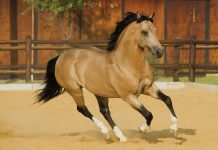Do you have a feeding chart for your pony posted somewhere in the barn? If you don’t, you should! If you can’t get to the barn to feed your pony, a feed chart will tell your mom/dad/pony pal/barn staff how to feed your pony. It’s important to feed your four-legged friend the same amount of his normal feed every day if you want his digestive system to work properly.
Here is some information to remember about feeding your favorite pony:
Feed little and often
If your pony lived in the wild, he’d nibble on grass all day long. This is because his tiny stomach is designed to digest small amounts of food at a time. To fit in with nature’s routine, split his feed into several small feeds a day. Don’t just feed one big meal a day.
Feed ready-made feeds
Unless you are a horse nutritionist and know all about horse feeds, it’s best to give your pony a ready-to-eat feed that comes in a sack. These complete feeds have all the vitamins and minerals your pony needs to stay healthy, and there will be instructions on the sack telling you approximately how much feed he needs each day. Check out the feed manufacturer’s website to learn more about feeds.
All the water he wants
Your pony must have an unlimited supply of fresh, clean water to drink. Horses can drink more than 13 gallons of water a day! The need water to keep their digestive system working properly and to prevent them from becoming dehydrated and sick.
Slow changes
Don’t change a pony’s diet overnight. Ponies have delicate stomachs and doing this can cause colic (an equine stomach ache.) If you are switching your horse from sweet feed to pellets, do it over a week. Start out by feeding 3/4 sweet feed and ¼ pellets and gradually add more pellets and decrease the sweet feed as the week progresses.
Feed for need
Don’t feed an 11hh Shetland Pony the same amount as a 16.2hh Thoroughbred. Take into account your pony’s size, type, age, breed, workload, temperament, time of year and the way he is kept when figuring out how much and what to feed him. Talk to a vet or an experienced horse person to help you develop a suitable diet for your pony.
Hay, hay and more hay!
Horses and ponies were meant to eat grass, so your pony’s digestive system needs tons of fiber (which comes from grass) to keep it working properly. Of course, not every field has tons of grass in it, so most people feed hay (dried grass) as well.
Talk to a vet about how much hay your pony should eat every day. Some people give their ponies hay “ad lib”, which means as much as they can eat.
No thanks to stale feed
If you open a feed bin or sack and the feed smells weird or looks moldy, don’t feed it to your pony because it could make him sick. Only offer fresh, high-quality feed to your pony. A feed sack may have sat in the sun too long or been hidden away in the storeroom until it’s sell-by date expires. If feed smells funny or looks stale, take it back to the store and they should give you a new sack of feed.
The scoop on supplements
Supplements are substances (usually powders, pellets or liquids) that are added to a horse’s diet in case he’s not getting all the nutrients, minerals and vitamins he needs in his food to stay healthy. They can also be fed to help a health problem a pony is experiencing.
If your pony is plump and only eats hay, he may need a daily multi-vitamin, similar to the one you chew up every morning. If he’s arthritic, he may benefit from a joint supplement that helps lubricate his achy joints. And if he’s got crumbly feet, you could add a biotin supplement to his diet to help strengthen his hooves.
Juicy treats
Ponies love carrots and apples and they are good for them. If your pony doesn’t get much grass, feed him four apples a day to replace some of the nutrients he misses out on by not eating the tasty green stuff! Always slice carrots lengthways and apples in quarters.





